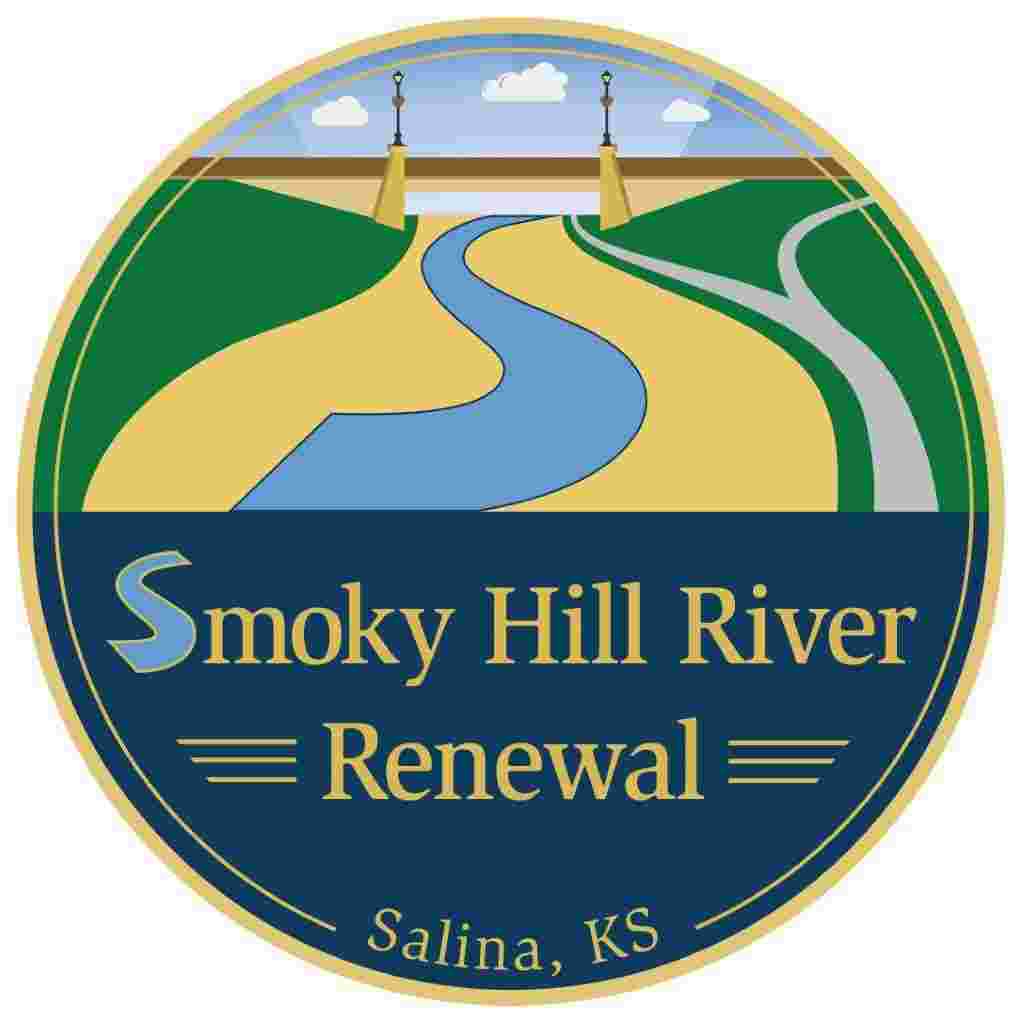Smoky Hill River Renewal


Click for Smoky Hill River Renewal Project Progress Updates
The Smoky Hill River Renewal Master Plan was adopted by the City in 2010 and identifies the community's priorities and goals for the renewal of the Smoky Hill River that winds 6.8 miles through Salina, Kansas. The original river alignment through town was isolated in the 1960's by the construction of a levee and a bypass channel on the Smoky Hill river. The original river alignment (old channel) has no sustained base flow and has accumulated sediment. The old channel continues to receive stormwater flows from approximately 75 storm sewer outfalls. The City has obtained a water right to divert a portion of the Smoky Hill base flows into the old channel however, due to the sedimentation and various undersized culverts; a restoration effort is needed. In addition to restoring the base flow, an Urban River Walk is desired for a portion of the channel near downtown. The USACE KC-District 1135 Ecosystem Restoration cost share program may bring an additional $10 million in funding to the non-river walk sections of the project. Efforts related to the USACE involvement are covered in a separate contract.
In May 2016, voters approved a sales tax increase from 8.40% to 8.75% that will be in place over 20 years. A portion of these sales tax funds will be used for Smoky Hill River Renewal projects and will allow restoration efforts to move forward. When the annual debt service for Kenwood Cove ($1.3 million) is retired, those sales tax funds will be allocated to the Smoky Hill River Renewal Project. At $1.3 million per year for 16 years, a total of $20.8 million would be generated.
In April 2017, the City Commission authorized HDR Engineering (HDR) to develop the preliminary design of in-channel features and the greenway trail that was shown in the 2010 Master Plan (see below). HDR worked with the City and the public (steering committee) to obtain input on areas of the 2010 Master Plan that required refinement due to existing or changed conditions and budget constraints. Refer to the 2017 Smoky Hill River Renewal Refined Master Planning Process below.
In January 2018, the City Commission executed a cost share agreement between the United States Army Corps of Engineers (USACE) and the City for a Section 1135 Smoky Hill river Aquatic Ecosystem Restoration Feasibility Study. The Feasibility Study will result in a plan to restore water flow, degraded wetlands and stream habitat.
In December 2021, the City Commission selected Alternative 2 - Pools and Riffles as the Locally Preferred Plan to allow the USACE to complete the Feasibility Study. This alternative includes an excavated channel that is designed with the riffles, runs and deeper pools of water that will have the appearance of a natural river. This alternative provides the most ecosystem benefits and will be more favorable when reviewed by the North Western District of the USACE. The USACE will fund $10 million towards the project.
For more information visit: www.smokyhillriver.org
2010 Smoky Hill River Renewal Master Plan
In December 2009, the City Commission authorized Design Studios West, Inc. and Wright Water Engineers, Inc. to complete the Phase 2 Old River Channel Master Plan. The Old Smoky Hill Channel winds 6.8 miles through the City and was isolated in the 1960s by construction of a flood control levee and bypass channel. The original river alignment (old channel) has no sustained base flow of water and has accumulated sediment and urban debris. The old channel continues to receive stormwater flows from approximately 75 storm sewer outfalls. The purpose of the Master Plan is to identify appropriate planning, design, and preliminary engineering responses to specific opportunities associated with the restoration and redevelopment of the old river channel of the Smoky Hill River.
Community meetings were held to allow the public to offer opinions and ideas on how the Master Plan could best address a variety of public and private improvements. The Master Plan identifies improvements, locations, general costs, potential funding sources, recommended phasing, and operation and maintenance costs. A Technical Advisory Committee and Master Plan Advisory Committee were formed to provide input to the consultants, with the Technical Advisory Committee providing oversight on the technical regulations and policies related to the Master Plan project area, and the Master Plan Advisory Committee providing oversight to ensure consistency in direction so that community desires were considered and reflected. In August 2010, the City Commission accepted the Smoky Hill River Renewal Master Plan.
Revitalizing
Smoky Hill River
Our transformative utility project rejuvenates the river ecosystem for sustainable water management.


Click for Smoky Hill River Renewal Project Progress Updates
The Smoky Hill River Renewal Master Plan was adopted by the City in 2010 and identifies the community's priorities and goals for the renewal of the Smoky Hill River that winds 6.8 miles through Salina, Kansas. The original river alignment through town was isolated in the 1960's by the construction of a levee and a bypass channel on the Smoky Hill river. The original river alignment (old channel) has no sustained base flow and has accumulated sediment. The old channel continues to receive stormwater flows from approximately 75 storm sewer outfalls. The City has obtained a water right to divert a portion of the Smoky Hill base flows into the old channel however, due to the sedimentation and various undersized culverts; a restoration effort is needed. In addition to restoring the base flow, an Urban River Walk is desired for a portion of the channel near downtown. The USACE KC-District 1135 Ecosystem Restoration cost share program may bring an additional $10 million in funding to the non-river walk sections of the project. Efforts related to the USACE involvement are covered in a separate contract.
In May 2016, voters approved a sales tax increase from 8.40% to 8.75% that will be in place over 20 years. A portion of these sales tax funds will be used for Smoky Hill River Renewal projects and will allow restoration efforts to move forward. When the annual debt service for Kenwood Cove ($1.3 million) is retired, those sales tax funds will be allocated to the Smoky Hill River Renewal Project. At $1.3 million per year for 16 years, a total of $20.8 million would be generated.
In April 2017, the City Commission authorized HDR Engineering (HDR) to develop the preliminary design of in-channel features and the greenway trail that was shown in the 2010 Master Plan (see below). HDR worked with the City and the public (steering committee) to obtain input on areas of the 2010 Master Plan that required refinement due to existing or changed conditions and budget constraints. Refer to the 2017 Smoky Hill River Renewal Refined Master Planning Process below.
In January 2018, the City Commission executed a cost share agreement between the United States Army Corps of Engineers (USACE) and the City for a Section 1135 Smoky Hill river Aquatic Ecosystem Restoration Feasibility Study. The Feasibility Study will result in a plan to restore water flow, degraded wetlands and stream habitat.
In December 2021, the City Commission selected Alternative 2 - Pools and Riffles as the Locally Preferred Plan to allow the USACE to complete the Feasibility Study. This alternative includes an excavated channel that is designed with the riffles, runs and deeper pools of water that will have the appearance of a natural river. This alternative provides the most ecosystem benefits and will be more favorable when reviewed by the North Western District of the USACE. The USACE will fund $10 million towards the project.
For more information visit: www.smokyhillriver.org
2010 Smoky Hill River Renewal Master Plan
In December 2009, the City Commission authorized Design Studios West, Inc. and Wright Water Engineers, Inc. to complete the Phase 2 Old River Channel Master Plan. The Old Smoky Hill Channel winds 6.8 miles through the City and was isolated in the 1960s by construction of a flood control levee and bypass channel. The original river alignment (old channel) has no sustained base flow of water and has accumulated sediment and urban debris. The old channel continues to receive stormwater flows from approximately 75 storm sewer outfalls. The purpose of the Master Plan is to identify appropriate planning, design, and preliminary engineering responses to specific opportunities associated with the restoration and redevelopment of the old river channel of the Smoky Hill River.
Community meetings were held to allow the public to offer opinions and ideas on how the Master Plan could best address a variety of public and private improvements. The Master Plan identifies improvements, locations, general costs, potential funding sources, recommended phasing, and operation and maintenance costs. A Technical Advisory Committee and Master Plan Advisory Committee were formed to provide input to the consultants, with the Technical Advisory Committee providing oversight on the technical regulations and policies related to the Master Plan project area, and the Master Plan Advisory Committee providing oversight to ensure consistency in direction so that community desires were considered and reflected. In August 2010, the City Commission accepted the Smoky Hill River Renewal Master Plan.